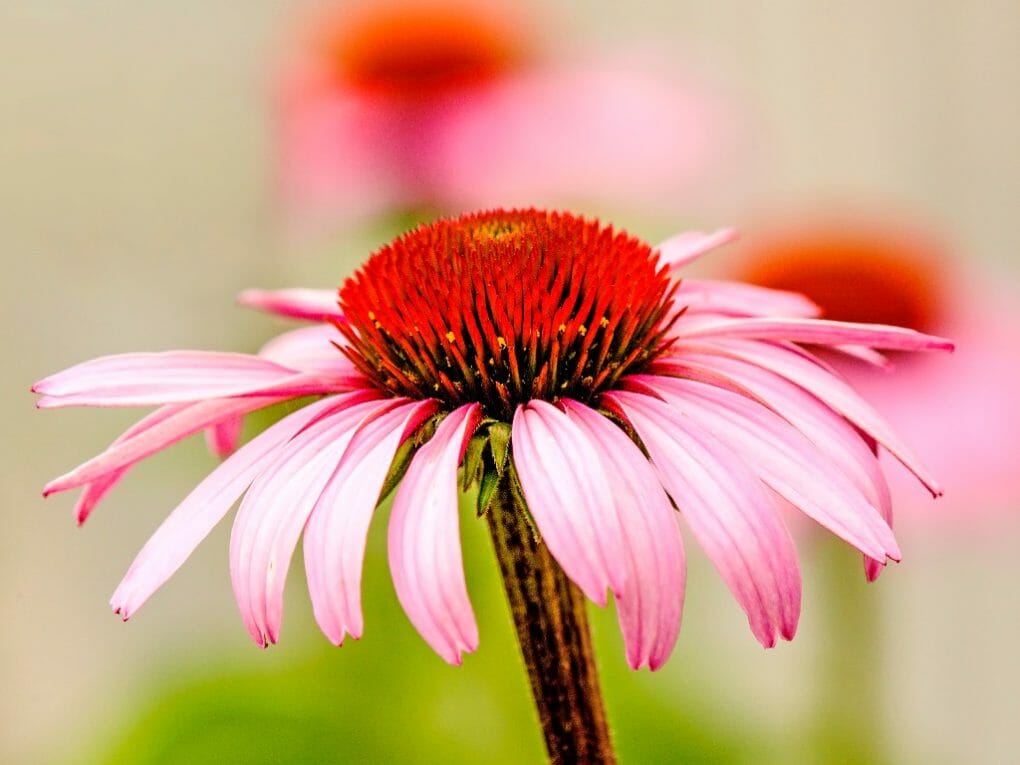34 Flowers That Go With Peonies

Peonies are among the most popular flowers in the world, and many different types go well with different flowers. In this post, we’ll show you some flowers that go well with peonies and give tips on how to care for them. We hope you enjoy it!
Table of Contents
Bearded Iris
Consider the bearded iris if you want to complement your peonies with another beautiful plant. This plant has orange, yellow, blue, pink, purple, and red frilly flowers. It’s comforting to know that bearded irises are visually distinct from other varieties. The flowers’ drooping shape recalls a beard, drawing comparisons that are sure to be noticed.
The fact that bearded irises require little maintenance should sway you toward adding them to your garden. Most gardeners will find this plant an excellent option because of its low care requirements.
Siberian Iris
It receives less attention than the more well-known and popular bearded irises within the vast Iris genus, despite having some advantages over them. Siberian irises, like other irises, have strappy, sword-like leaves. However, unlike other irises, the leaves of the Siberian iris are still quite attractive long after the flowers have faded, providing a texture similar to that of ornamental grass. In contrast to most bearded irises, Siberian irises can survive and even thrive in gardens as far north as USDA Hardiness Zone 3.
Columbines
It’s difficult to be indifferent to the beauty of columbines. When planted next to peonies, they will complement the fuchsias while still standing out.
The fully bloomed flowers of this species have two distinct layers of petals. The vibrant colors will help make your garden stand out. This plant in your yard will attract hummingbirds, a beautiful sight to behold. Columbines are a favorite of hummingbirds, so expect them to visit frequently.
Allium
The allium is a tall, erect plant with colorful, rounded blossoms. Blossoms come in round shapes and colors, including blue and purple, giving your garden a new and exciting appearance. These blooms have a unique kind of beauty that’s distinct from peonies.
Due to squirrels’ difficulty reaching these flowers, some gardeners prefer to use them in their landscaping. If you have trouble with animals ruining your flowers regularly, planting alliums may help.
Rose
Roses, without a doubt, are some of the most beautiful flowers in the world. The rose’s iconic status as a symbol of love and romance is not without foundation.
It only makes sense to plant roses near the peonies because they will enhance their beauty. Roses and peonies work well together because their colors and styles are complementary.
You can use the roses to highlight the peonies’ natural beauty, or you can try to achieve the most spectacular effect with just the roses. Planting roses in your yard will improve their aesthetic value regardless.
Bleeding Heart
In your garden, a bleeding heart will attract lots of admiring glances because it is such an unusual and intriguing flower. The blossoms of this plant typically bloom a soft pink color and feature heart-shaped petals.
It’s simple to understand why this plant is so famous for backyard gardens. Additionally, they are generally hardy plants, so you need not worry too much about animal damage.
Boxwood
Boxwood is a shrub or small tree that grows around six feet tall. This plant’s foliage is a glossy green, and its blooms are light pink. This plant can sometimes be challenging to find because they do very well in shaded areas. However, boxwoods are the perfect candidates if you’re looking for an exciting and eye-catching addition to your yard.
Foxgloves
Flowers like the foxglove are classified as “spike bloomers” by some. In contrast to the spherical peony blossoms, these flowers form along a spike.
Foxgloves are an excellent complement to peonies in a floral arrangement. For example, if you prefer the look of lupines or delphiniums, you could use those instead of the suggested spike bloomers.
You can find a spike bloomer that works well for you. Depending on your preference, you can place shorter varieties in front of shorter peonies or taller varieties behind taller peonies.
Hydrangeas
In this case, hydrangeas will be a natural fit because of their vibrant color and because they will bring out the peonies’ best qualities. If you decide to plant these in your yard, prepare to be impressed by the large, vibrant flowers.
Blooms on hydrangeas tend to be either purple or pink. The flowers can also be a rosy purple color.
If you’re looking for low-maintenance plants, you should also consider these. The only genuine care hydrangeas need regular watering.
Hostas
Since hostas are typically associated with shade, this pairing may come as a surprise. On the other hand, the peony is known as the “queen of the sun.” But they can find common ground in the middle.
Some hostas, especially those with lighter green leaves, can tolerate a good amount of direct sunlight. Sun-loving hostas with more delicate foliage include ‘Sum and Substance, and ‘Dancing Queen.
Contrary to popular belief, peonies do not thrive in the midday sun. Their blossoms will last longer in a partially shaded area. Finding a spot with partial shade is ideal for both perennials, perhaps an eastern exposure.
Lavender
Would it look good to plant lavender at the base of the peonies? Small, purple, slightly fuzzy flowers bloom on lavender plants.
These plants are also well-known for their pleasant aroma. Lavender is used in a wide variety of laundry detergents, most likely due to its popularity as a fragrance.
Lavender plants need to be given a good soaking whenever they are thirsty, but otherwise can go for a while without water. This is a lovely plant that could work well in your garden beneath the peonies.
Daffodils
Daffodils are a great option if you want to add plants to your peony arrangement. If your garden could use a splash of color, these large, sunny blooms are just what you need.
You can’t go wrong with either of these options if you’re looking for low-maintenance plants to put in your yard. To keep daffodils flourishing, you must give them a good soaking every few days.
Many varieties of peonies will complement the yellow nicely. Daffodils are a lovely addition to any garden, but they may need to fit in with your color scheme.
Camellias

Large and grand, camellias may be mistaken for roses by the uninitiated. These shrubs have a maximum growth diameter of 12 feet and bloom pretty flowers.
Another interesting fact about camellias is that they live for so long. It’s possible to find camellias that have survived for a century.
You’ll find beauty in the flowers’ gentle appearance and the perfect roundness of their petals. Camellias are a good substitute for roses if you don’t want to plant them in your garden.
Pincushion Flower
The Pincushion flower is a low-maintenance plant that will bloom all summer long. If you want to put this type of flower in your peony arrangement, choose one that blooms prolifically. This means the petals may curl or droop, and the stem may be weak or brittle.
Geraniums
Geraniums are a great option if you’re looking for plants that can handle some shade. If your peonies are in full sun all day, planting geraniums near them will help offset the peonies’ bright color. If you have room, planting several flowers around your peony shrubs is a great way to add life and beauty to your yard.
Daylilies
Alongside peonies, daylilies might be some of the best flowers to plant. Not only do the flowers and leaves of this plant stand out for their quality, but the texture of the leaves also stands out.
Daylilies provide a nice contrast to peonies, which is one of the reasons why you should consider using them. They will look good when planted close together.
Daylilies are also relatively simple to maintain. Daylilies are an additional beautiful flower option that should be considered by anyone looking to plant flowers.
Azalea
Azaleas are common types of shrubs found in many people’s yards. Having this type of evergreen shrub in your yard can be highly beneficial.
Frequently, azaleas are planted near the base of peony plants. It aids in concealing the base and maintains an attractive appearance.
As an added benefit, azaleas planted beneath peonies can support them. This is beneficial for peonies that are somewhat top-heavy.
Alyssum
In other words, if you’re going for a traditional English garden look, you’ve found the winning combination. It’s an annual with a short life cycle and many fluffy, fragrant flowers. And when you combine the floral scent of sweet alyssum with that of particular peonies, the result is nothing short of divine.
Clematis
Planting clematis along a trellis or fence creates a beautiful, verdant backdrop against which to display peonies. Clematis comes in many forms, each with its unique blooming schedule.
This early spring flowering alpine clematis is a testament to the plant’s hardiness and robustness. Jackmanii, a tried and true variety, blooms later, possibly co-flowering with peonies. Peonies look lovely against a lush green background, and it doesn’t matter if they bloom simultaneously or in succession.
Clematis, as a bonus, appreciates shady, cool footing. There is an early appearance of peonies above ground. They can shield the clematis’s underside from the sun and keep it from drying out.
Columbine
Anchoring a garden with peonies is a great idea. They’re consistent, expand with time (given the right conditions), and never move. With the peonies planted and stabilized, you can begin experimenting with the rest of your garden’s nomads.
Your garden style will determine this. If you like neat, straight lines, only put in plants that stay where they’re planted. However, if you enjoy a kaleidoscope of hues and textures, filling your space with flowers wandering around is a great idea.
To conclude, the columbine is the ideal wandering flower for your garden. Columbine is a garden plant that can be somewhat aggressive. It spreads by seeding itself and poking around in a garden. They can be easily removed if they appear in unexpected places.
Coneflower

Adding coneflowers to a peony garden is a great way to add depth to your flowerbed. The peony blooming period is brief and occurs early in the growing season. The large peony blossoms risk being lost in the shuffle if you fill your garden only with plants that flower simultaneously.
The role of coneflowers becomes clear in this context. Once the peonies are ready to bloom, it’s just a boring green perennial. The stems are a moderate height, and their simple green, pointed leaves are all the same size. Blooming peonies are neither thrilling nor particularly impressive.
While peonies are fading into memory by late summer/early fall, the giant daisy-like blossoms of the coneflower are just beginning to open. They’re beautiful and add a splash of color later in the season, making them a perfect match for the peonies.
Creeping Jenny
If peonies are reserved for early bloomers, then jenny plants are the flower that late bloomers take to bed with them. They’ll bloom all summer long if you’re willing to water them regularly and not be too particular about their planting location.
The big, dark blossoms of creeping jenny add a lush texture and color late in the garden season. The blooms can reach up to two feet tall, so they require some attention but won’t overwhelm your other plants.
Larkspur
To put it simply, larkspurs are just another name for delphiniums. They go together like delphinium and peonies. They go together like peanut butter and jelly in an English garden. In front of the delphinium, plant some peonies. Even though they don’t always bloom at the same time, delphinium makes for a beautiful curtain of lacy foliage behind the peony.
Once the peony has finished flowering, the delphinium takes center stage with its towering spikes of brilliantly colored blooms. Depending on the sun exposure of your peony and delphinium varieties, there may be some or a lot of overlap of blooms. They are the definition of a perfect pair.
Lupine
Lupine can be an aggressive weed in some areas. Remove seed pods. Lupine’s deeply lobed foliage and colorful flower plumes are unique.
Lupine and peonies make a great pair. Lupine’s tall perennial blooms are spectacular and happen before peonies. Both have stunning flowers. Blooming after flush keeps your garden attractive. Both plants have nice foliage
Masterwort
The masterwort is a beautiful perennial. It can mature to about the size of a peony or even a little larger. It has these intricate and delicate little flower fireworks.
While their blooming time coincides with peonies, their flowers last much longer than the latter’s fleeting petals. Colors like pink and white are used because they are so gentle and feminine. The full, fluffy peony blossoms starkly contrast with the masterwort’s tiny, spikey flowers. They have similar, deeply lobed leaves that look interesting and go well together.
Monkshood
It doesn’t need to be staked because it stands tall and solid. Peonies look beautiful against the tall, lacy foliage surrounding them, similar to that of delphiniums.
Flowers appear later in the summer after peonies have already opened. It has tall stems covered in purple, white, and pink blossoms. The flowers resemble tiny hooded monks, which is fitting, given their name.
When pests like deer and rabbits are a problem in your garden, consider planting some monkshood instead. There is nothing that would dare try to eat one of these because they are so deadly.
Painted Daisy
It is a beautiful bright flowers that rise above feathery fern-like foliage. The majority of them are pink or red. Peonies and painted daisies have similar bloom times and are roughly the same size. Daisies’ straightforward flower design pairs well with a peony’s complex ruffles and folds.
Pansy
The large, flat flowers of the pansy provide a lovely contrast to the big, fluffy blooms of the peony. Flowers like peonies and pansiesthrive in a cool spring garden. Both will sputter and die if the temperature is too high. Matrix White or Matrix True Blue pansies are great options for bringing out the best in peonies because they won’t compete with the flower’s attention-grabbing hue. Another beautiful choice is violas. When the small flowers bloom together, they form a carpet from which the peonies can emerge.
Salvia
The long, dark purple flower spikes are a stunning contrast to the shorter, lighter pink flower spikes of peonies like the popular Sarah Bernhardt variety.
It’s hard to find a more visually arresting floral combination than salvia and peonies, which bloom at the same time and are nearly the same height. They make beautiful bouquets when grouped. Together, they make a formidable force.
Sea Holly

This perennial is an odd choice, but it is effective. The plant’s framework had fully developed when the peonies were in full bloom.
When the sea holly is just beginning to produce its spiky bloom, they stand at about the same height. It lacks vibrancy and only serves as a framework for the show-stopping peonies.
Snow in Summer
The silvery-velvet leaves of the perennial Snow in Summer are beautiful. At the base of a peony, it looks stunning. It shares its peak flowering season with the peony, and its snow-white blossoms make a breathtaking carpet. This twosome appears dreamy and romantic.
When combined with peonies with darker flowers, like ‘Kansas,’ ‘Karl Rosenfield,’ or ‘Chocolate Soldier,’ the effect is stunning. Even when the plants aren’t in bloom, the contrast of the foliage is beautiful.
Sweet Woodruff
In the garden, sweet woodruff makes a pretty ground cover. Small, glossy, and delicate, its foliage is a perfect ground cover for the area around your peonies. Furthermore, it can be used as a natural mulch to prevent the growth of weeds and preserve soil moisture.
This plant’s tiny white star flowers bloom simultaneously with the peonies (or a bit earlier, depending on your location and the specific variety). The big, bold peony is set off beautifully by the dense clusters of smaller flowers.
Tulips
Tulips are another great bloomer for planting around peonies. They come in all shapes and colors. Additionally, tulips help add a splash of color to an area that might feel too bland.
Tulips and peonies form gorgeous bouquets in many different colors when planted together. They work well as filler plants or as part of larger flower arrangements.
Ornamental Grass
Numerous enthusiasts believe that the leaf texture of ornamental grass pairs well with peonies. The only consideration you must make is the type of grass you plant.
Wide varieties of ornamental grasses spread rapidly. Some of them are considered invasive, and if you’re not careful, the grass could potentially spread and harm the peonies.
Choose a grass that is simple to maintain, such as blue fescue. You won’t have to worry about the burgundy bunny grass spreading too far and smothering the peonies if you choose it as an alternative.
